Christmas in Christ Chapel History
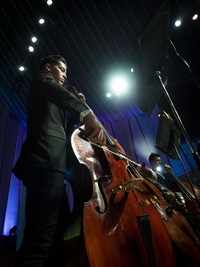
A tradition since 1973, Christmas in Christ Chapel is a time for the Gustavus Adolphus College community to celebrate the holidays with one another. Over 300 students, faculty, and staff bring the program to life each year through the use of music, dance, spoken word, and the visual arts. A new theme is chosen each year with choirs and orchestras performing live for over 5000 audience members.
O Come All Ye Faithful has been the closing hymn since the beginning. The current version was commissioned for Gustavus in 1976. In 1979 organizers closed with Handel's Hallelujah Chorus instead. The negative responses made it clear that a tradition was firmly in place.
Support Christmas in Christ Chapel
| Year | Theme | Artwork |
|---|---|---|
| 1973 |
Advent Vespers |
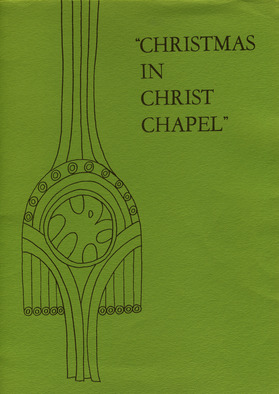 |
| 1974 |
Lessons and Music in the Celebration of the Incarnation of Our Lord |
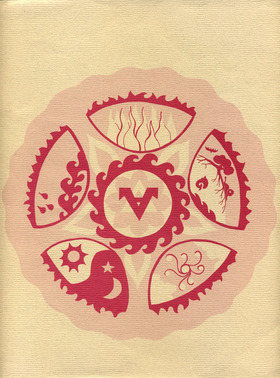 |
| 1975 | ||
| 1976 |
Nativity |
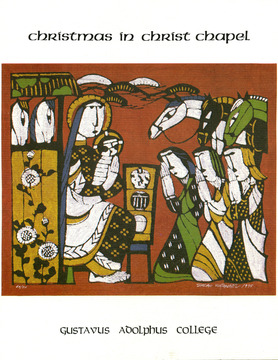 |
| 1977 |
Christmas in Christ ChapelThere is something Russian and Northern which we have placed at the liturgical center of the Christmas celebration this year, an echo of ancient relationships between the Russian and the Scandinavian people. You will hear it in the chant, see it in the gesture and recognize its themes in the music of Rimsky-Korsakov. Finally, you will sense it in the Eastern poet's embellishment on the Christmas Biblical texts - the Troparion and Kontakion. From this center it spreads out in the music of many people. We pray you hear tonight, the "angels singing." The theme of that singing is Jesus Christ, and the meaning of that singing concerns the worthfulness of your own existence, that is, the gift to live it as a child of God in this world. |
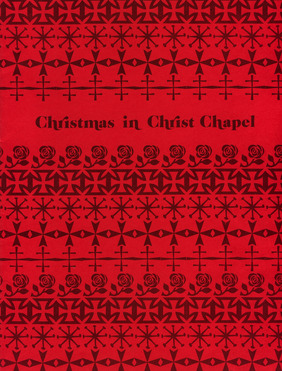 |
| 1978 |
Glory to GodAround the cross entwines the Christmas rose. Although it is a black cross - a cross of cruelty and bitterness, of so many accidents - it does not kill, but brings life. For on this night the Gospel of God begins to grow upon it. A plant from a distant land, but behold it blossoms in this wintry northern church! So we may love cursed earth, man's destiny, so bitter and vain. So we many love the Holy Child. The Gloria Excelsis is the high hymn in the service of praise. To give glory to God and to beg His mercy are the two purposes which link man to God in this song of praise. It is because we know that God is Almighty that we beseech Him to have mercy on us. Luther said the Gloria "did not grow, nor was is made on earth, but it came down from heaven." The Gloria in Excelsis was most likely introduced into the Eucharistic service in the Western church in connection with the Christmas vigil. This is particularly appropriate because of the reference to the song of the angels at the time of our Lord's nativity. |
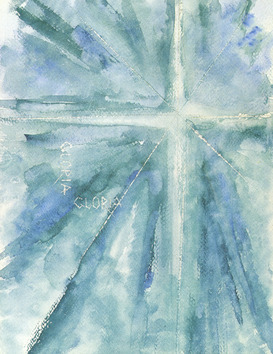 |
| 1979 |
Hail the Day |
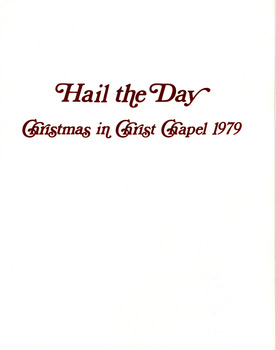 |
| 1980 |
Christmas Vespers |
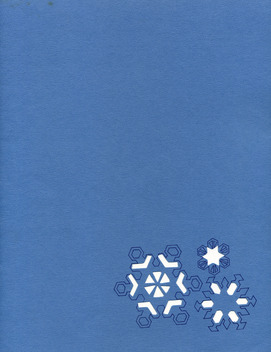 |
| 1981 |
Angels |
 |
| 1982 |
Choral Vespers "A Service of Light" |
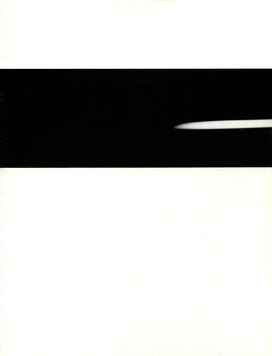 |
| 1983 |
"Unto Us… A Child""Unto Us...A Child" is the theme of Gustavus Adolphus College's eleventh celebration of Christmas in Christ Chapel. Because of the college's many Swedish ties and because one of the featured musical works this year is Swedish composer Hilding Rosenberg's major Christmas cantata, Den Heliga Natten, this program has been designed using traditional Swedish Christmas motifs. The paintings reproduced on the cover and within are examples of "Dalmalning," or Dala painting. These painting, common in the Dalarna and nearby provinces of Sweden in the early and middle 1800s, were generally executed directly on the walls of the homes and churches in the countryside by traveling artists. Biblical themes were frequently used, embellished with kirbitses, decorative floral patterns. The Dala paintings selected for the Christmas in Christ Chapel '83 program depict the Annunciation, Nativity, and visit of the Wise Men. Note the artists have painted their subjects dress of the day, a quaint folk style that serves to associate the events more directly with the everyday experiences of the rural folk who lived with these paintings. |
 |
| 1984 |
Soli Deo Gloria: Evening Music for the Birth of Our Lord; Celebrating the Anniversaries of Bach, Handel, and SchultzSoli Deo Gloria - "To God alone the glory" - is the phrase Johann Sebastian Bach wrote at the end of many of his compositions. It is also a fitting thematic phrase for this year's Christmas music service at Gustavus Adolphus College, the twelfth such program held at the college. This year's celebration, in addition to singing the birth of Jesus, commemorates the births of Bach and two more of the world's great composers - George Frederic Handel, who like Bach was born in 1685, and Heinrich Schutz, who as born a century earlier. The music of these three composers dominate Christmas in Christ Chapel 1984 and gives a decidedly German "Abendmusik" flavor to the celebration. Complementing the texts of their music in this program are works by artists active in the 1600s and early 1700s and other images relating the composer to the so-call "Baroque" era in which they lived and worked. |
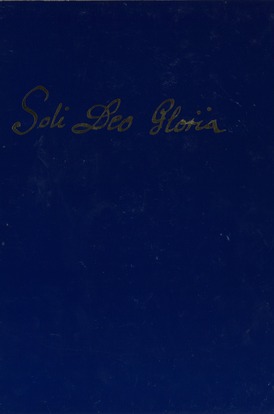 |
| 1985 |
Service of Lessons and CarolsIn 1985 at Christ Chapel we return to a Christmas service much loved here in the 1960s. The Service of Lessons and Carols was performed each year from the Chapel founding in 1961 until the retirement of Dr. Paul Allwardt, organist and choirmaster, in 1972. When our "Christmas in Christ Chapel" program was inaugurated in 1973, we moved away from that format. Now it seems appropriate that we return to the Service of Lessons and Carols. One of the most beloved British traditions of Christmas, it is a uniquely collegiate service, allowing a college community which honors Word and music to celebrate its Lord's nativity. So, we a glance at the past, at this year's British Festival in Minnesota, and at the charm of this service from a sister college chapel in England, we decided to do it once again. The beauty of this form of worship is in its flexibility and its musical dialogue based upon a special sequence of readings, prayers, and choral, instrumental, and congregational song, which is necessary to and makes up the One community that is the College. The readers are appointed after a definite order - at a college, for instance, from a campus urchin down to the president. This is the College at worship. You may join in, too, as we sing the familiar hymns. Peace. We love you. |
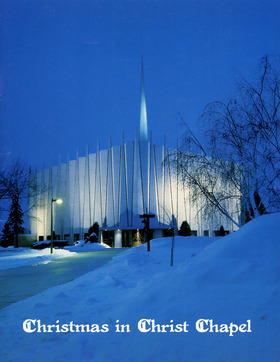 |
| 1986 |
Russian service of Great VespersFor the music at Christmas in Christ Chapel 1986, we consider the rich liturgical heritage of the Russian Orthodox Church. Our service is shaped by the liturgy of the Russian service of Great Vespers. The melodic richness, color, and strong emotional appeal of its many hymns and litanies are familiar to Minnesotans for several reasons: 1) in the 1920s F. Melius Christiansen recognized the value of the Russian a Capella style for use by the Midwestern college choirs, particularly the compositions of Gretchaninoff. The Christiansen tradition came to Gustavus under the directors of Philip Knautz and Karle Erickson. 2) the Service Book and Hymnal (1958) introduced the Eucharistic prayers and a litany that originated in the Eastern tradition which are continued in the Lutheran Book of Worship (1978). 3) the Russian composers of the nationalistic period which we hear in this service have always been popular in Minnesota: Tchaikovsky, Mussorgsky, Rachmanioff, and Borodin. This is a visual service.The movements of the choirs, the dancers, and the clergy through the church; the icons, the candles and the incense, the gospel book carried in solemn procession to the center of the nave, all suggest the ambience of Russian sacred space. In January of 1987, the Gustavus Choir will travel in the Soviet Union. With them go our prayers for peace between our peoples. As we look over the news from the political summits, and reflect on the United States foreign policy, we feel deeply the need to encourage our leaders and to stir ourselves to weave the fabric of peace with the Russian people, and to give to that undertaking every energy of mind and heart. The light of Christmas judges the darkness and cynicism in which we seem content to live. The wonderful poetry and music of Christmas opens our eyes to the condemnation of much that seems so important to us, and is not ultimately important. Because the day-spring from on high has visited us, we move with quickened step across the miles of prejudice and ignorance, ancestral blindness and inertia, on a highway to a better world - a Bethlehem world. "God is with us! O ye nations understand." |
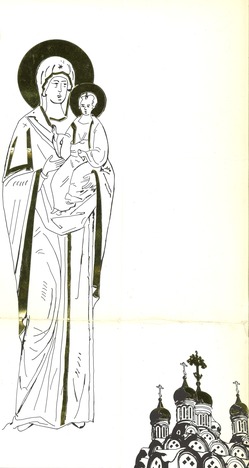 |
| 1987 |
Celebrating the Old and New Worlds from Which We Have ComeThe Autumn days advanced upon the Minnesota landscape early this year. Already in October the tree factories were out of work, and stood about like dull brick walls in the setting sun of a post-industrial city, all the windows empty. The land lay exhausted beneath "the base, the withered tree." "We walked the sodden pasture lane" to stalk the pheasant and the deer. November shortened our days, shrank the circle of the sun. Now in December, the darkest month, night comes shivering to supper. Even the lights of the village are small comfort. Lights are unimportant. They no longer seem to radiate. We long for the crystal lights of the deep winter sky. We long for something from the dark sea of infinity to approach us, to venture beyond our limits, to enter our finitude with a new revelation. In the north countries, Norway, Sweden Denmark, Finland, and Minnesota, it begins with one small candle. A "living light" we call it. Such is the simple harbinger of the Northern Christmas - the Advent light! And it beings to light the way to Christmas. |
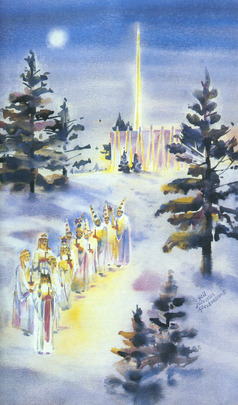 |
| 1988 |
"The primordial light, that enlightens everyone, was coming into the world" |
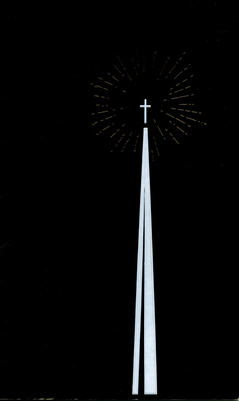 |
| 1989 |
ChristMass For The AnimalsWe may say that Ecology is the science of the Body of God, theology the science of the Body of Christ, the arts the science of the Body of the Spirit; One Body through which we, the earth community, learn our sacred connectedness. The church is that public space that invites all earth's creatures to taste the sweetness of the Age of the Incarnation. In any event, that is how we hear it. Listen for yourself with our blessing and prayers for you and your family, your whole family. Richard Q. Elvee |
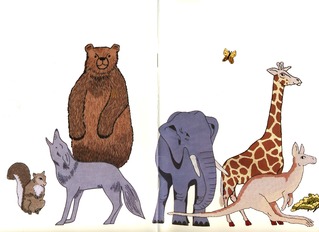 |
| 1990 | A Rose in Winter: The Life of Mary | |
| 1991 |
Of the Father's Love BegottenDecember 6 is the feast day of the great patron saint of colleges and the Christmas season, Saint Nicholas. He comes to our cathedral to be enthroned, as once he came to the ancient cathedral of Myra. He takes up the symbols of his office, and preaches to us a sermon on the Father's Love. |
 |
| 1992 |
Christmas in Christ ChapelWelcome to the 20th presentation of Christmas in Christ Chapel. One of the unique features of our annual celebration of the birth of Christ is that is takes place in Christ Chapel and that worship is central to our coming together. This is no less true this year as we begin the service with the beautiful and moving Bidding Prayer used in the Service of Lessons and Carols performed annual at King's College in Cambridge, England. We shall "once again hear the message of the angels, and in heart and mind go even unto Bethlehem and see this thing which is come to pass, and the Babe lying in a manger." We shall join our voices with those in the choirs and become our own angelic chorus as we wing the carols of the faith. This service consists of five sections which are delineated by the Scriptural texts. We begin with the birth of Jesus, who is the "glory of the Lord revealed to all flesh," and progress to the announcement of the angels and the musical variations on "Glory to God." Next, we contemplate Mary's role, especially as she ponders the angel's message to her and all that others have said about this child. A contemporary hymn brings her humanity to us in a most poignant way. Our drama moves from contemplation and wonder concerning the child to feeling the power of the man he grew to be - "King of Kings and Lore of Lord!" Finally, all moods give way to a breaking forth of the joy that is found through this event, a joy that knows no bounds and is for all eternity. It is the joy that may be ours in the midst of pain, defeat and death as well as in the days of health, peace, and prosperity. The Revered Dennis J. Johnson |
 |
| 1993 |
A German Christmas: A Celebration of the Nativity of our Lord with a Salute to Old and New LeipzigThe city of Leipzig was founded on an elevated plateau between three rivers in Saxony, central Germany, on the site of a settlement dating back to 4000 years before our time. The city derives its name from the fishing village which originated here: "Lipzi" (place under the linden trees). Over the centuries it became of the the great trade and cultural cities of the world. Here the King's road and the Imperial road crossed. Here trade fairs were organized, medieval churches were built, guilds of craftsmen formed - cloth-maters, tailors, tanners. In 1409 Leipzig University was founded. At first it educated mainly lawyers and theologians but then increasingly in the Renaissance, Reformation, and Enlightenment periods , it became a great humanistic institution repeatedly attracting important lecturers and students.Leipzig has always attracted great composers and musicians. Of course, it is Johann Sebastian Bach who comes to mind first. The numerous publishing houses and the university created ideal conditions for making Leipzig a literary and cultural center.On the night of December 4, 1943, Leipzig was bombed by the Allied forces. The valuable historical buildings were not spared. One-fifth of the city was completely destroyed. Between 30,000 and 40,000 Leipzig citizens died during the attacks. Since the ware, the desolate state of the city, the continual demolition instead of restoration of entire areas of the city until the beginning of the 1990s, the removal of complete villages and areas of the countryside to make way for open-cast lignite mining and the helplessness of the population against ignorance and the high-handed politics of the lies on the part of the government are some of the hundreds of reasons for the Leipzig demonstrations on October 9, 1989. These and subsequent demonstrations gave important impetus to the peaceful revolution that changed the heart of new Leipzig. |
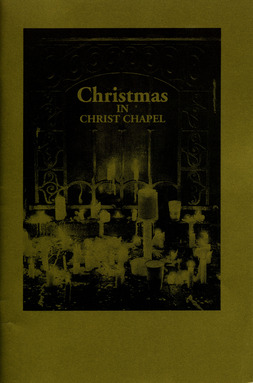 |
| 1994 |
Old and New Spain: Prepare for an Age of AbundanceThe celebration of the seasons of Advent and Christmas is surrounded in every culture by tradition, custom, and familial celebration. The Mexican-Americans bring a richness of faith and celebration to these seasons. The month of December is filled with festivities that draw families into the mystery of the Incarnation. The first part of December is dedicated to the celebration of the feast of our Lady of Guadalupe. The appearance of the Virgin Mary to Juan Diego, a native Mexican, is a central part of the devotion of the Mexican people. Dedicated to our Lady of Guadalupe, exsecutus sum meum votem |
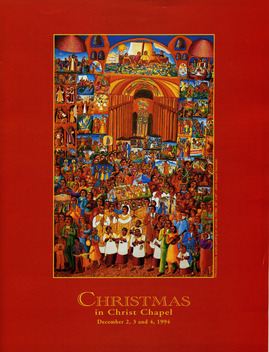 |
| 1995 |
The Tree of Life |
 |
| 1996 |
Child of Light |
 |
| 1997 |
Portals of Prophecy and Promise |
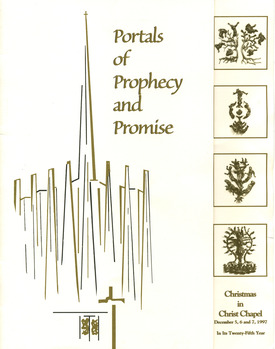 |
| 1998 |
The Holy FamilyTonight our journey begins with the dreaming Joseph as he reflects on his ambivalent decision to become Mary's husband. We dream with prophetic texts and are sobered by the reminder of the future of the Christ child. Next we meet Mary as she encounters the angel and Elizabeth. A silent and poignant birthing ends with the holy family fleeing as refugees to Egypt because of Herod's slaughtering of the innocents. We finally return as extended family to the temple for a blessing by Simeon and a sermon from Anna. We sing for the first time a new setting of the hymn "Awake, Awake, and Greet the New Morn," for choirs and congregation, brass, orchestra, and organ composed by Robert Buckley Farlee. We hope that, as we rehearse this old story, you leave Christ Chapel blessed in your families and share with them a new sense of wonder at this birth - this gift of life. This is how our troubled souls are answered by God, write Mechthild of Magdeburgh (translation by Davies): It is my nature that makes me love you often, for I am love itself. It is my longing that makes me love you intensely, for I yearn to be loved from the heart. It is my eternity that makes me love you long, for I have not end. Chaplain Brian T. Johnson |
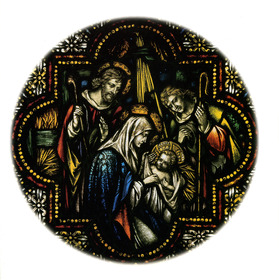 |
| 1999 |
Even So, Come, Lord Jesus: Scenes From The RevelationA sense of immediacy, of urgency, of eager expectation, throbs in the texts of this service. They are impetuous, insistent, athrill with impending revelations and unguessed disclosures. They move swiftly, like a herald approaching, bringing tidings of incredible happenings about to transpire. One feels the stir of new impulses, of nameless prophecies, as of a Divine Order brooding over the life of our time, trying to break it up. The City of God is descending to those ready to receive it. As we gather in these final weeks of the millennium, let us remember the words of the refrain of the Revelation oracle: "Hear, you who have ears to hear, what the Spirit says to the churches." No other biblical book can be compared to the Revelation of Jesus Christ in terms of its history of influence. In the ancient and medieval church its significance far exceeded that of the Pauline letters, or even that of Matthew's Gospel. With its rich visual language it provided the intellectual material on which Christian piety fed. St. Augustine, who speaks to this chapel from Paul Granlund's east door, is our instructor. He said that John's Revelation should not be interpreted literally or as future-telling, but as an allegory of the everyday struggle between good and evil, the church and world, the city of God and the city of Man. In farewell, I wish to dedicated this program to my colleagues in the Chaplain's Office and the music and dance departments at this College. You have been superb as artists and directors. To the genius of Kelvin Miller and the competence of the Office of Public Affairs, I raise my Erasmus Cap. To my father, Richard Elvee (1911-1968), and my mother Nelle Beacham, Sun City, Arizona, for teaching me the love of this book since I was a child. And finally to my fathers in this College: Edgar Carlson, Ren Anderson, Kyle Montague, and Millard Ahlstrom. It is not enough that I think of you often, you gentle men, who were not my kin but as dear to me; mentors who shared with me your love of learning and culture and Gustavus. Richard Quentin Elvee |
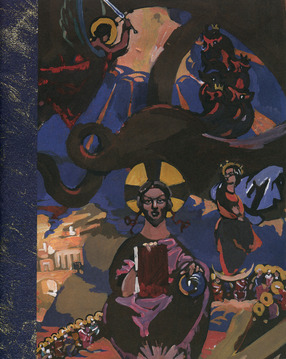 |
| 2000 |
Heaven and Nature SingWelcome to our celebration of the Lord's Nativity! This great festival of the Incarnation of the Word of God, brought near to us in texts and the arts each year at Christmas in Christ Chapel, is a renewal and a restoration of all the forces and powers of the universe: Christ is the instrument, the center, the end of all animate and material creation. Through this divine Logos, all things are created, sanctified, and made alive. This is the constant and customary teaching of St. John and St. Paul, the teaching conveyed by the most solemn chants of liturgy. Though we repeat these chants across generations, we recognize that we can neither master nor measure their mysterious and profound significance. Yet as we come to embody their power, we realize that the Creator is by nature always in the act of creating. It is Christ who is reaching fulfillment in the creation. The Word becomes flesh and dwells in us. Abiding peace and joy as we await Christ's birth, |
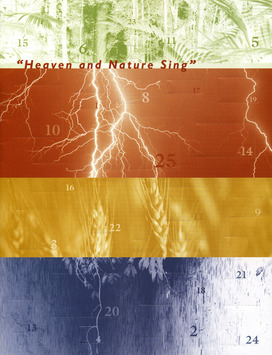 |
| 2001 |
A Celtic PilgrimageWelcome to Gustavus as our community joins in pilgrimage and prayer to celebrate the Lord's Nativity! Each year in this prairie cathedral we combine our voices to the song of the Church, a song which resounds from every time and every place. In preparing for Christmas in Christ Chapel, faculty and chapel staff listen for new or distinct voices, or ones that may have been forgotten or overlooked, so that we might discover a fresh, audible Word that comes to meet us with a touch of grace. We trust that the voices across the ages bring our community of faith to new places as we celebrate Christ's birth in the depths of our hearts. Peace to Christ, the eternal Word made flesh. Peace during these Advent Days, |
 |
| 2002 |
Julbon Christmas PrayerBrothers and sisters, as we samlas vid krubban (gather around the crib) to prepare for the Lord's Nativity, welcome to a liturgy of sight and song, of memory and movement, of Word and worship. In a starlit, sacred space, this Christmas in Christ Chapel liturgy joins the revelations of saints and Holy Scripture with naverlur and nyckelharpa musicians, folk and modern dancers, hymns and carols of Advent and Christmas season in Sweden. Drawing on recently published materials from the Church of Sweden, the College's exchange programs with Uppsala University, a recent visit from renowned Swedish poet Ylva Eggehorn as our Out of Scandinavia writer-in-residence, and a rich history of relationship and connection with Sweden, this 30th anniversary year of Christmas in Christ Chapel celebrates a continuing legacy. Advent prayers for the coming of God's living Light, |
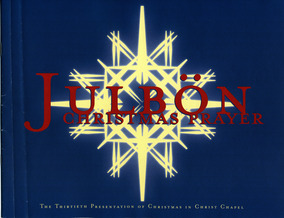 |
| 2003 |
Some Children See HimAs we festively gather among the pine boughs and shining ornaments, welcome to Christmas in Christ Chapel celebrating our Lord's Nativity! This year we are linked with King's College, Cambridge, which has celebrated for 85 years the Festival of Nine Lessons and Carols on Christmas Eve. "Wherever the service is heard and however it is adapted, the pattern and strength of the service," as Dean Eric Milner-White pointed out, "is derived from the lessons. The main theme is the development of the loving purposes of God" seen "through the windows and words of the Bible." Local interests appear in our bidding prayer, and personal circumstances open the heart to different parts of the liturgy. The center of the service is still found by those who go in heart and mind and who consent to follow where the story leads. Chaplain Brian T. Johnson |
|
| 2004 |
Seasons of PromiseAs the Gustavus collegiate community gathers to listen to and participate in the feast of Christ's birth, you will discover in this year's celebration that the Nativity is embedded in a greater cycle of time (temprale): Seasons of Promise. May the promise inherent in a relationship with God be born in you anew in this time of prayer and praise. |
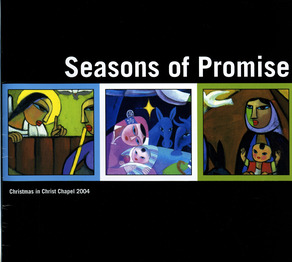 |
| 2005 |
Ageless Visions of a Timeless MomentBlessings during this time of waiting and preparing, a time of holding two different Advent practices together, yet embracing a richness and depth that only is known in their pairing. Such is the paradox of this year's Christmas in Christ Chapel. Even though the moment of Jesus' birth occurred in history, it also represented an encounter between eternity and time itself. Likewise, as musicians, visual artists, and writers attempted to capture something of the truth of this timeless moment by their unique visions, that which has been heard and known transcends a particular age. The pieces of art found herein speak across the ages and become part of the ongoing record of being present at the birth of our Savior. Peace, |
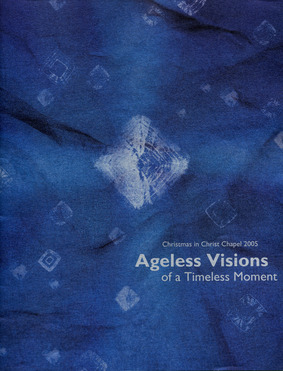 |
| 2006 |
An American OdysseyWelcome to Christmas in Christ Chapel 2006. We are pleased that you have come to join as our collegiate community celebrates the Nativity of our Lord. May this season of anticipation bring you warmth and hope. |
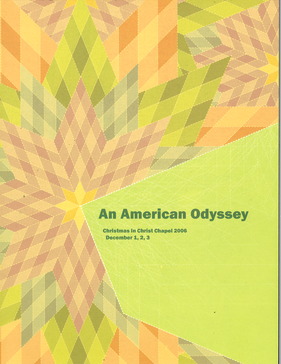 |
| 2007 |
The Word Becomes FleshFor 35 years, Christmas in Christ Chapel has been a place of pilgrimage and worship during the Advent season. On these introductory pages, in the College library, and in the Jackson Campus Center you will find images from some of our previous liturgies. These emblems are lasting reminders of the rich themes that have broadened and deepened understandings of the Nativity of our Lord. This year, we think and feel with poets who have lived within the biblical texts and, through encounter and response, have offered seekers imaginative acts of attention. Our writers give us personal interventions, mediations, and creative inquiries, and bequeath to us experiences of the inheritance of faith, the gift of belief bestowed across time and space. Truly, the Word becomes flesh and dwells in, with, under, and all 'round each of us. |
 |
| 2008 |
Joyeux NoelAt first glance, rising before the worshiping community in Christ Chapel, is an icon of Mary and Jesus painted for the community of Taizé in France. This icon, a window of light into the birth of God, connects us to the aesthetic charism of the French church, whose artistry, music, and texts shape this year's liturgy and serve to deepen the mystery of the Nativity. In France we encounter the legacy of organists and composers like Olivier Messiaen, whose 100th birth anniversary is celebrated this year. It was his experience of stained glass windows that helped him to imagine the colors of music, and his inspiration draws us in the printed program to images from the great cathedrals of France. Saints like Bernard, Therese, and Teilhard complement the Biblical texts of prophecy and birth. Robert Bukley Farlee has arranged a new setting of the French carol "People Look East," joining French composers like Poulenc, Durufle, and Honegger. Our Advent liturgy concludes with a chant from Taizé, introduced in French but sung in multiple languages, the Pentecost expression of living as a parable of community, the voices of the church joining the voices of the ages. In Advent anticipation, |
 |
| 2009 |
A Liturgy of Letters and CarolsDear Brothers and Sisters, With love, |
 |
| 2010 |
A Renaissance NativityThe birth of Jesus has inspired a flowering in countless cultures of creativity as artists, musicians, poets, and dancers have interpreted its meaning. It is appropriate, then, that Renaissance (Italian: "Rinascimento," from ri-"again" and nascere "be born") as a cultural movement and as a metaphor has been chosen as this year's theme. Peace during these Advent days, |
 |
| 2011 |
Julljus: Light from the Old World, Light to the NewAs the earth tilts away from the sun and toward the time of the winter solstice, we in the northern hemisphere find ourselves descending into darkness and longing for light. We are not the first to yearn for the light. We celebrate the faithful seekers who kindled the flame and carried the light, often through great adversity. Their voices sound from medieval times into this new millennium. Ansgar and Birgitta, Petri and Norelius, Carlson and Yang tell stories of being drawn to the light. Words near the votive candelabra in the Cathedral in Uppsala, Sweden, also grace the Christ Chapel candelabra: Ljus för Andra Lägg en gåva och tand ett ljus. Bed en kort bön, om du kan, för någon du håller av, eller någon som behöver se Guds ljus i sitt liv. God Jul! |
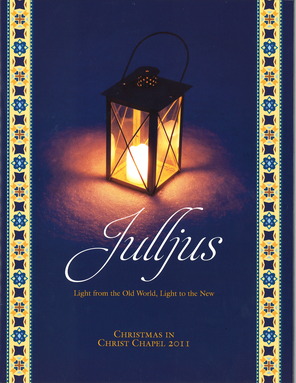 |
| 2012 |
Jubilee, Proclaiming the Year of the Lord's FavorCome In, All Ye Faithful Thank You for COMING to behold Him . . . and GOING to make the world whole. |
 |
| 2013 |
Holy Wisdom, Holy Word: The Gate of Eden Are OpenThe readings and music at this year's Christmas in Christ Chapel services explore the meaning and impact of the incarnation from a variety of feminist theological perspectives. Over the past four decades, an increasing number of women have earned the PhD in biblical studies, Christian theology, and Christian history. Those who have entered the academy have made significant contributions to their fields and have lifted up stories, voices, and insights from a tradition that has long been undervalued or ignored. The thread that runs through this year's service is the Wisdom of God. In the book of Proverbs and other ancient texts, God's Wisdom is often personified as feminine. In the Greek translation of the Hebrew Bible, Sophia is the word for wisdom. In the English tradition, she is often referred to as Lady Wisdom, the one who was with God at the beginning of God's creative work. Some feminist scholars have pointed out the parallels between the Wisdom of God and the Word of God in the Christian tradition, with Jesus as the incarnation of both God's Wisdom and Word. |
 |
| 2014 |
Tender Rose, Starry NightThe Nativity of Jesus has always been a cosmic story, not just a human one. The theme for this year's services was inspired by another signature event of the College, the Nobel Conference. This October, Gustavus hosted its 50th Nobel Conference, centered around the question, "Where does science go from here?" Because of its longstanding commitment to the interconnectedness of faith and learning, the Nobel Conference has often also included a theologian, ethicist, or philosopher who explores the implications of scientific research for people asking questions of faith and meaning. This year during Christmas in Christ Chapel, we will ponder the cosmic significance of Jesus's humble birth in light of scientific discoveries about the vastness and magnificence of the universe. God's relationship with the created world has been affirmed throughout the sacred writings of Judaism and Christianity. The earliest biblical writers speculated about God's role in the creation of life on earth. In each era of scientific advance, people of faith have wondered anew about God's activity in the material universe. Since the first century of the Common Era, Christians have made cosmic claims about Jesus: that in him the Word of God, present with God in the creation of the universe, became incarnate in a material body. And, that through his life, death, and resurrection, God is at work redeeming the whole creation. Today we understand that Jesus's flesh, like all human bodies, was made up of stardust, that human beings share 99 percent of the same DNA as chimpanzees, that human life is deeply dependent upon the well-being of the earth, and that our universe is much grander and expansive than previous generations could have imagined. These scientific discoveries encourage us to expand our vision of God and to reflect on the significance of Jesus's birth from a much larger vantage point. In this meaning-making we have able guides. As you encounter the work of some of Christianity's most creative theologians, mystics, poets, dancers, and musicians, we invite you to prepare your hearts and minds to celebrate another Christmas, inspired anew by this amazing, unfolding cosmic story of birth and life. Blessings, |
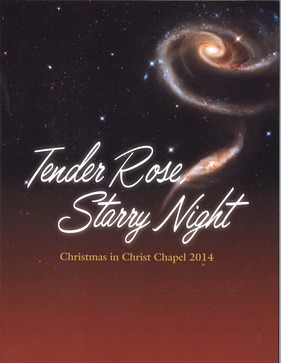 |
| 2015 |
Shalom, Salaam BethlehemEvery year, thousands of people from around the world make the pilgrimage to the city of Bethlehem, in Palestine, to celebrate Christmas. Processions, lights, and music fill Manger Square, the streets, and the churches. This year, Christmas in Christ Chapel will take you on a journey, joining global travelers and the residents of Bethlehem to celebrate the birth of the Prince of Peace and give voice to our shared hope for shalom, salaam—peace in this world.
|
 |
| 2016 |
Ubuntu, Jesu: From the Cradle of Humankind to the Ends of the EarthCommunity is what often defines identity in various locations across the African continent. For some, this is called "Ubuntu," or as John S. Mbiti stated, "I am because we are, and since we are, therefore I am." In striking contrast to our common manifestations of western individualism, Ubuntu conveys that "a person is a person through other persons." As Bénézet Bujo recognizes, "a person only remains healthy in a holistic sense by living in harmony with the whole creation," thus "to be human is to affirm one's humanity by recognizing the humanity of others and, on that basis, establish humane relations with them." While popularized by Desmond Tutu and Nelson Mandela during the anti-apartheid struggle in South Africa, the concept of Ubuntu has numerous variations in a wide range of African linguistic expressions, such as gimuntu in kiKongo and giKwese (Democratic Republic of Congo and Angola), umuntu in xiTsonga and shiTswa (Mozambique), bumuntu in kiSukuma and kiHaya (Tanzania), umundu in Kikuyu and umuntu in Kimeru (Kenya), and bomoto from Bobangi (Democratic Republic of Congo). In recent years, feminist scholars such as Puleng LenkaBulu and peace activists like Timothy Murithi have taken Ubuntu in provocative and profound directions. Today the Gustavus Adolphus community contributes to this important conversation. The Ubuntu relationship of individual and community can be bserved in the baobab tree, which is featured on the cover of this program and expressed artistically and prominently in our scenic design. The baobab tree is considered sacred across the African continent, as it is tall, majestic, strong, and imposing; much like the spirit that holds the human community together in all its diversity, reminding us of our common ancestry and collective trajectory. At a time of great division and painful isolation in 2016, both locally and globally, we gather under the inspiring and reconciling baobab to celebrate Christmas in Christ Chapel, under our theme "Ubuntu, Jesu: From the Cradle of Humankind to the Ends of the Earth." To proclaim "Ubuntu, Jesu" is to boldly connect the incarnation event of Jesus with the totality of life in its fullness for all that exists. The "Cradle of Humankind," therefore, has a double meaning. First, it is the physical location of Africa as the birthplace of humanity, and second, it is the manger of Jesus, the Son of God. Therefore, "Ubuntu, Jesu" communicates our shared origins and dignified character, "From the Cradle of Humankind to the Ends of the Earth." This weekend each worship service begins with artistic choices grounded in the African continent, and through music, dance, and the spoken word, subsequently migrates to expressions from around the world. In doing so we follow four topical sections: Creation, Alienation, Incarnation, and Proclamation. Not only does this sacred progression seek to illustrate the theme of Ubuntu, but it also mirrors the arc of Scripture, echoes a historical Lutheran worship presentation, and honors the Christian liturgical calendar while affirming the relational Trinitarian formula. In making such connections, we take notice of our common creation, temptation for alienation, celebration of incarnation, and call to proclamation, in the hope that we might receive the spirit to embody Ubuntu throughout advent, Christmas, and beyond. Like the roots, branches, leaves, and fruits of the baobab tree, we as human beings are interconnected with all things in all places and at all times. In the words of former Gustavus President Edgar Carlson, "We need each other to become ourselves." As we celebrate the birth of Jesus through the lens of Ubuntu and under the sacred baobab, may we recognize our roots and reform our reach, for the sake of all that exists. May God continue to bless you, with peace and all things good, today and always. Rev. Brian Konkol, PhD, Chaplain of the College and Creative Director, Christmas in Christ Chapel Paschal Kyoore, PhD, Professor of French and Director, African Studies |
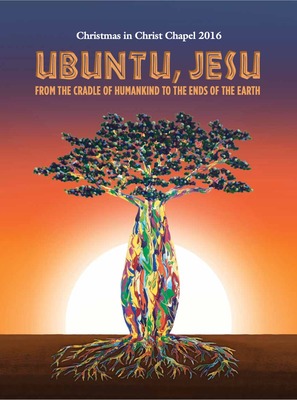 |
| 2017 |
Life Abundant: A Celebration of Chrismtas during the 500th year of The Reformation |
|
| 2018 |
Visions of Devine Mystery |
|
| 2019 |
Love Beyond BordersIn Love Beyong Borders, we explore artistically and theologically how it is that the incarnation illuminates God's persistent movement to transcend the boundaries that separate heaven from earth, spirit from flesh, and resident from immigrant. As told in the Gospel of Matthew, Jesus' birth is surrounded by stories of border crossings. The nativity begins with a recounting of the geneology of Jesus. Through this ancestral naming, we see evidence of a God who has been guiding generations of people as they have migrated to new lands in search of food in times of famine, fled violence in places ruled by tyrants, and lived as exiles within an enemy's empire. After Jesus' birth, the magi travel to a foreign land with the guidance of a special star. They undertake this journey in order to nonor the holy family with lavish gifts. The story of Jesus' infancy ends with his family fleeing King Herod's violence by migrating to Egypt. For a time, the holf fmaily lives as refugees in this unfamiliar nation, where they figure out how to survice and meet their daily needs in a place that is not own. An angel announces the final border crossing in the story by encouraging the hold family to return to the land of Israel and make a new home in a town called Nazareth. Through these events, we learn of a God who cannot be contained by any border and who encourages people to transcend boundaries for the sake of love and abundant life. As we immerse ourselves in this ancient story, let us be mindful of all the people in our world today who are migrating in search of safety, peace, opportunity, and a chance to create a better life. May God's love, which knows no limits, move us to compassionate and courageous action in our world today. Rev. Siri Erikson Christmas in Christ Chapel Artistic Director Chaplain of the College |
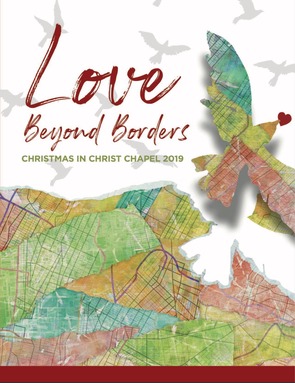 |
| 2020 |
Healther of the Nations, ComeAcross centuries, cultures, and nations, the writers of the Bible consistently wrote about their experiences of God's restoring power and proclaimed that a God who heals was present and active in their lives. As we approach the Christmas season this year, we do so with a longing once again to notice and welcome God's everpresent gift of healing in the form of health, wellbeing, and reconcilliation. This year's Christmas in Christ Chapel service is a program created collaboratively by our team with the purpose of proclaiming the message of God's love to you through music, scriptures, dance, and visual elements. It is our sincere hope that this service is a balm to your soul and communicates the power of God's presence to you in a way that is tangible and real. The structure of this year's service follows a more traditional lessons and carols format, including nine biblical readings that anchor the message of the service. The lessons, read by faculty, staff, and students in a variety of languages, span the full reach of the biblical text, from Genesis to Revelation, and demonstrate the many ways that the Bible gives witness to God's love and creativity through healing. In the center of the program we focus on the Nativity stories, for it is in and through the person of Jesus that God's saving grace became flesh in a new way. The gospel writers used the Greek verb "sozo" frequently in reference to Jesus' ministry; in some verses it is translated in English as "to heal", in other stories it is translated as "to save", and in still other passages it is translated as "to make whole". The verb ‘"sozo" means all of these things: to heal, to save, and to make whole. The first hearers of these gospel stories would have known that each time the word "sozo" was used in reference to Jesus, it carried all of these meanings. God's saving work in Jesus is about healing people and making them whole. It is about reconciling divided communities. It is about ushering in peace between nations. In this time of uncertainty, sickness, division, and fear, this is the good news of the Christmas story. May it be a blessing to you and to the world. On behalf of our whole Christmas in Christ Chapel team, Rev. Dr. Siri Erikson Chaplain of the College |
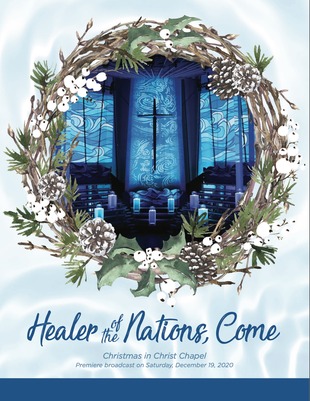 |
| 2021 |
We Shall Go Forth SingingWe Shall Go Forth Singing is a celebrations of resilience and beauty in the midst of great struggle. This year's service begins from a place of lament. To lament is to cry out to God, weaving our own sorrows and experiences within the sacred stories of scripture. This season, we still find ourselves lamenting lives lost, communities fractured, and all that has hurt in the last year and a half. Our lament is about more than naming an event that has happened but living within a reality that is still happening. By speaking our lament, we hold hope for a different future. Along with Mary, we boldly proclaim that another world is being birthed among us—one where the lowly will be lifted up, the hungry filled with good things, and our stories remembered. With the shepherds, we hear good news that eases our fears. With the angels and the whole multitude of heavenly hosts we sing praise for God's impending peace. Through the hope of the Christ child, we journey to a place of inspiration and good courage, knitting ourselves back together in defiance of the forces that seek to tear us apart. We are the authors of our stories and together we will proclaim that our collective story is not yet finished. We are resilient like trees that stand tall through the changing seasons and withstand the storms by deepening and spreading their roots, anchoring themselves in the ground. We will celebrate and speak of joy even in the midst of our sorrow. May this service be a gift of hope from the Gustavus community to you. May you be strengthened and inspired to dream of a better world and to speak that world into existence for those who cannot yet imagine it for themselves. May we come together in radical joy and together may we go forth singing. Maggie Falenschek and Michele Rusinko Artistic Directors |
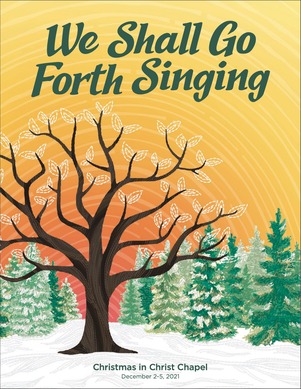 |
| 2022 |
Celestial Wonder Joy UnfoldingWelcome to Christmas in Christ Chapel 2022! Our service this year is a bold, dramatic, and lively celebration of the Nativity centered on two thematic ideas. One is wonder, seen in the human fascination with the celestial realm of planets, stars, and the universe beyond our terrestrial reach. The other is joy, heard in the stories of the two mothers in the Nativity story. These women, Mary and Elizabeth, respond in an intimate, personal, and human way to the news of the birth of Jesus. In 2021, we defiantly declared "We Shall Go Forth Singing" and summoned our energies to lift our voices as an act of rebellion and resilience against times of turmoil and uncertainty. As our team planned for 2022, we questioned, "What will be our next step, when we can act with more freedom?" We began with a sense of hope and imagined a service that would fill the entire space of Christ Chapel. We looked for a rich palette of music, dance, word, and art. Our efforts would invite all of creation to join in the celebration. We wanted to unfold from our tired bodies and joyfully sing, play, move, and speak with renewed energy. In choosing the music, one piece that came to mind was "Ring Out, Ye Crystal Spheres" from the Epilogue of Vaughan Williams' Hodie. This outburst of joy summons a cosmic music, described in the text by John Milton. "Crystal Spheres" is a reference to an old concept of the universe as a silently sounding set of interconnected spheres, each regulating the movement of the sun, moon, and planets. This ancient way of understanding the movement of the celestial bodies was an embodiment of wonder for those who saw God's creation everywhere. In his poem "On the Morning of Christ's Nativity," John Milton drew upon this image of cosmic harmony when joining together the birth of Christ with the creation of the universe Our service features spinning orbs and clouds suspended from the ceiling, dancers enlivening the words of poetry and scripture, light and color splashed on the walls of Christ Chapel, speakers and actors proclaiming poetic texts, and music of many moods and styles. Our student performers bring enthusiasm and dedication to the production of this service. We are pleased to feature the poetry of Meta Herrick Carlson, a Minneapolis-based writer, as well as a new musical commission by Chad Fothergill '06. May the whole experience fill you richly with wonder and joy. Chad Winterfeldt Artistic Director |
 |
